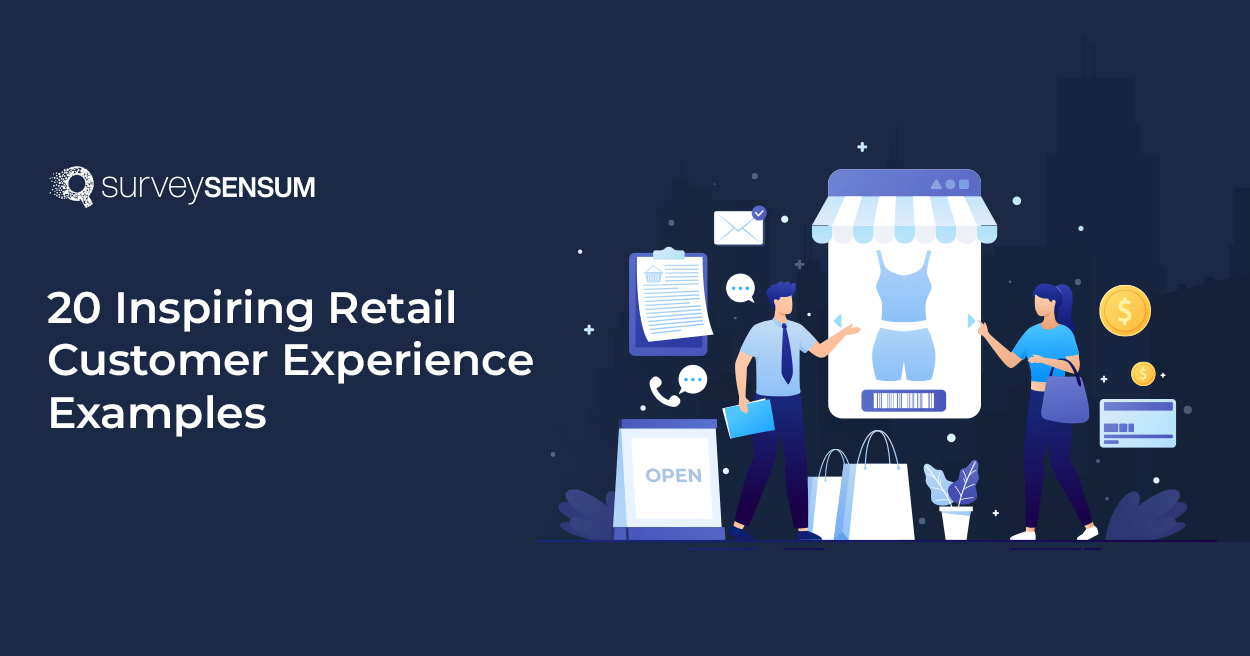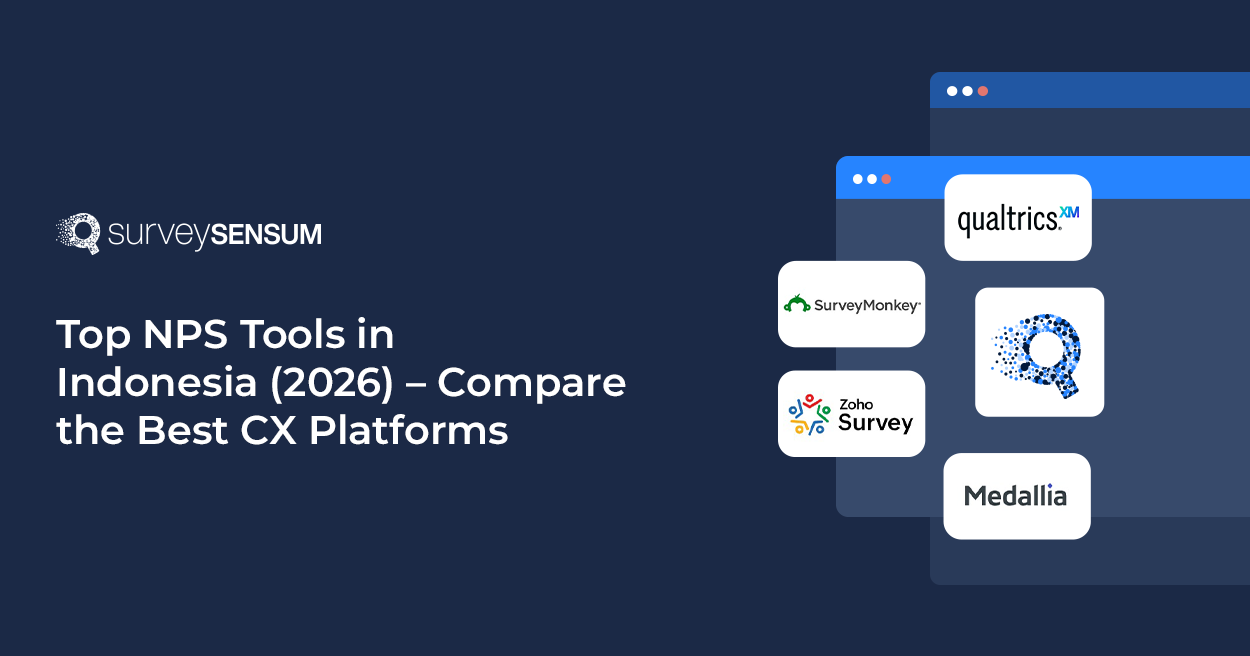

Three-fourth of customers prefer to buy from brands on the basis of their experience. That’s a lot, right?
This emphasizes the critical role that retail customer experience plays in customer loyalty, brand advocacy, and business growth.
By prioritizing personalization, delivering excellent customer service, and meeting evolving customer expectations, brands can forge stronger connections with their customers and gain a competitive edge in the market.
Without further ado, let’s delve into real-life brand examples that excel in customer experience using retail customer feedback tools.
20 Retail Customer Experience Examples: Brands Excelling in Customer-Centric Strategies
Explore 20 exceptional retail personalization examples that showcase the transformative impact of prioritizing customers.
1. Give Your Customers What They Want
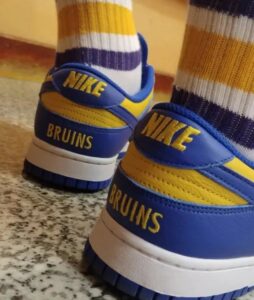
Nike is indeed winning hearts with its personalization in retail strategy, and one of the key ways they achieve this is by leveraging customer feedback.
One notable example of this is their introduction of the program ‘Nike By You.’
By actively gathering and analyzing customer feedback, Nike discovered that its customers desired the ability to design their own shoes or apparel.
So, Nike launched ‘Nike By You,’ a program that enables customers to customize their shoes with unique colors, materials, and designs.
This level of personalization allows customers to create personalized products that reflect their individual styles, resulting in a truly unique and memorable experience.
The focus on personalization not only enhanced customer engagement but also fostered a deeper connection between customers and the Nike brand.
2. WOW Them With Interactive Displays
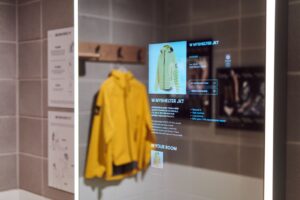
One notable example of interactive displays in retail is found at Adidas stores.
By leveraging the power of customer feedback they understood their customer’s needs and preferences and introduced interactive displays to make their experience more engaging and convenient.
They introduced interactive mirrors that recognize the items customers bring into the fitting room, displaying product information, alternative sizes, and complementary items on the mirror’s screen. This interactive display enhances the shopping experience, providing real-time recommendations and a seamless blend of physical and digital interactions.
In addition, Adidas integrates advanced inventory optimization software to ensure that the products displayed through these interactive systems are always available in the right sizes and styles. This technology not only reduces stockouts and overstock issues but also aligns real-time customer demand with supply chain efficiency, creating a smoother and more satisfying shopping journey.
3. Organize Engaging In-store Events
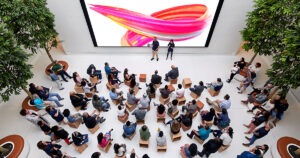
Some retailers organize special events to enhance the customer experience.
For example, Apple is known for hosting in-store events that offer customers unique and educational experiences. After listening to the Voice of the Customer, Apple realized that its customers might benefit from additional workshops and tutorial sessions.
Their “Today at Apple” sessions provide hands-on workshops and tutorials on topics like photography, coding, music production, and more. These events are one of the retail customer experience examples that foster community engagement, attract new customers, and enhance the overall customer experience by offering valuable learning opportunities within the retail environment.
4. Meet Your Customers Where They Are
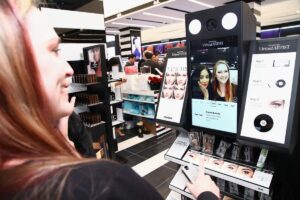
The goal of seamless omnichannel integration is to break down the barriers between channels, providing customers with a frictionless and convenient experience, regardless of the touchpoints they choose to engage with. To achieve this, many retailers turn to retail store planning software, enabling them to design layouts that prioritize customer convenience, improve product visibility, and enhance the overall shopping experience across every channel.
Sephora is a prime example of seamless omnichannel integration in retail.
By actively gathering customer feedback in real time and analyzing it they understood customer’s expectations and preferences when it comes to shopping.
Sephora has developed a robust digital ecosystem that bridges the online and offline shopping experience. Customers can browse products online, use virtual try-on tools, and then visit a physical store for personalized assistance or make a purchase. Supporting that kind of real-time, multi-channel experience at scale often requires the right tech stack. G2’s review of trusted contact center tools showcases platforms that help brands unify digital and physical support channels to deliver seamless service interactions.
5. Let Them Experience The Brand First
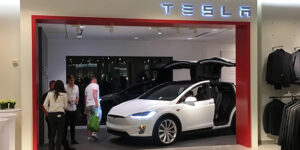
Showrooms provide a perfect opportunity to create amazing experiences for your customers. By harnessing the power of customer feedback you can create memorable and engaging shopping experiences for your customers.
One such brand that wins this is Tesla.
Tesla’s approach to retail is characterized by its experiential showrooms, known as Tesla Galleries. These galleries provide customers with an immersive and interactive environment to explore Tesla’s electric vehicles. Instead of a traditional car dealership, the focus is on educating and engaging customers about the unique features and benefits of Tesla vehicles.
Visitors can sit inside the cars, experience the touchscreen interface, and learn about advanced technologies. This experiential approach allows customers to truly understand the Tesla brand and its commitment to sustainable transportation, creating a memorable and influential retail experience.
6. Give Them Recommendations That They Don’t Even Know They Needed
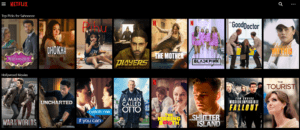
Netflix is a prime example of retail customer experience strategy of leveraging customer data and feedback to create personalized recommendations to enhance the customer experience.
Their recommendation algorithm analyzes users’ viewing history, ratings, and preferences to curate a tailored selection of TV shows and movies. By offering personalized suggestions based on individual interests, Netflix creates a highly engaging and relevant content discovery journey for each user.
This approach has been instrumental in driving customer satisfaction and retention, with 80% of content viewed on Netflix stemming from personalized recommendations.
Create a Personalized Experience for Your Brand!
7. Assist Them Beyond Shopping

By gathering feedback on customer needs, preferences, and specific requests you can create a concierge service for your brand which will help you in creating a personalized shopping experience for your customers.
Nordstrom excels in the concept of concierge services in retail through their Nordstrom Concierge Program. This personalized service offers customers a dedicated personal stylist who assists with styling advice, wardrobe recommendations, and personalized shopping experiences.
Customers can schedule appointments with their personal stylist, both in-store and virtually, to receive tailored assistance and personalized attention. This concierge service goes beyond traditional retail, providing a premium level of customer service and fostering long-term relationships with customers.
8. Use Augmented Reality (AR)
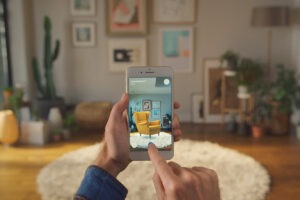
IKEA has embraced the use of Augmented Reality (AR) technology to enhance the customer experience. With the ‘IKEA Place mobile app, customers can virtually place furniture and home decor items in their own space using their smartphone or tablet.
By leveraging AR technology, customers can visualize how Ikea products will look and fit in their homes before making a purchase. This immersive experience provides customers with a greater level of confidence and eliminates the guesswork, resulting in more informed buying decisions and increased customer satisfaction.
9. Be Their Social Media Buddy
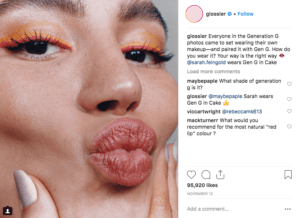
Retailers actively engage with customers on social media platforms, responding to inquiries, providing recommendations, and showcasing user-generated content. This level of interaction helps build a sense of community and strengthens the customer relationship.
This also provides you an opportunity to gather customer feedback and data for further personalization of your customer experience including key aspects of your brand identity such as your brand logo.
Glossier, a beauty brand, excels at engaging with customers on social media platforms like Instagram. They encourage their customers to share their makeup looks, skincare routines, and product reviews using branded hashtags, such as #GlossierPink. Glossier then amplifies this user-generated content by reposting it on their own social media channels, showcasing real customers and creating a sense of authenticity.
10. Make Things Happen – Quick & Easy!

Providing quick services in the retail industry is a key differentiating factor.
Amazon’s Prime Now service serves as a shining example of immediate satisfaction in the retail customer experience examples. Through Prime Now, Amazon offers ultra-fast delivery, often within a couple of hours, for a wide range of products, including groceries, household items, electronics, and more.
By gathering customer feedback in real-time Amazon streamlined its supply chain management and website from order placement to delivery.
Customers can now simply place an order through the Prime Now app or website and have their items delivered to their doorstep in record time. This instant gratification approach caters to customers’ desire for immediate access to products, providing convenience and enhancing the overall shopping experience.
11. Create Engaging Reward Programs

Starbucks has successfully implemented gamification in its retail experience through its Starbucks Rewards program. The program incorporates gamification elements by allowing customers to earn stars for each purchase, which can then be redeemed for free drinks and other rewards.
With customer feedback, Starbucks gains insights into customer preferences and expectations regarding rewards and benefits. This information allows them to make data-driven decisions when it comes to crafting loyalty programs.
By offering challenges, bonus stars, and personalized offers through the program, Starbucks encourages customers to actively participate and engage with their brand. This gamified approach not only drives customer loyalty but also adds an element of fun and excitement to the overall Starbucks experience, creating a sense of achievement and enjoyment for customers.
12. Leverage the Power of Virtual Reality (VR)

Some retailers are incorporating VR technology to offer immersive shopping experiences.
For example, Dior has leveraged VR technology to create immersive and interactive experiences for customers. One notable example is their use of VR headsets in select boutiques to offer virtual tours of their ateliers (workshops) and backstage areas during fashion shows.
Customers can explore behind-the-scenes Dior’s craftsmanship and get a closer look at the intricate details of their creations. This innovative use of VR technology not only adds a sense of exclusivity but also allows customers to engage with the brand in a unique and captivating way, fostering a deeper connection and appreciation for Dior’s artistry.
13. Surprise Them With Pop-up Shops
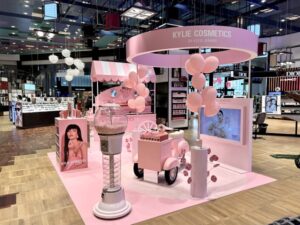
Pop-up shops provide a temporary and unique retail experience. By listening to the Voice of the Customers, brands can gain insights into customer preferences and expectations and design exciting events like pop-up shops for them.
Brands like Kylie Cosmetics have successfully created limited-time pop-up shops that generate excitement and exclusivity among customers.
By understanding customer preferences and desires, they can tailor exclusive deals and packages to match specific customer segments.
These temporary retail locations allow customers to experience the brand’s products in a unique and limited-time setting. Kylie Cosmetics pop-up shops offer exclusive product launches, interactive displays, and opportunities for fans to meet Kylie Jenner, the founder.
The limited-time nature of the pop-up shops also creates a sense of urgency, encouraging customers to visit and make purchases during the limited availability window.
14. Be Socially Responsible
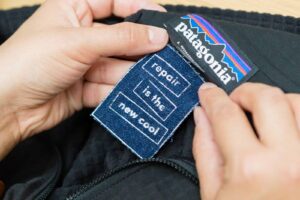
Social responsibility in retail refers to the ethical and sustainable practices adopted by retailers to positively impact society and the environment. By actively listening to your customers you can take actions to make your brand more socially responsible.
Patagonia is widely recognized as a leader in social responsibility within the retail industry. One prominent example is their commitment to environmental sustainability. Patagonia has consistently advocated for environmental causes and practices what they preach by incorporating recycled materials in their products and minimizing waste in their operations.
They have also pledged a percentage of their sales to environmental organizations, contributing to grassroots activism and initiatives.
15. Surprise and Delight!

Random acts of kindness or unexpected gestures can create a wow factor. For instance, Zappos is renowned for its exceptional customer service and surprising customers with unexpected upgrades or gifts.
Zappos’ customer service team has gone above and beyond to help their customers. Their longest customer service call is 10 hours and the best part is that the call wasn’t about any product, the customer just wanted to talk. The team has also helped someone order pizza at midnight which, again, wasn’t their job.
By connecting and actively listening to their customers in real-time, Zappos was able to create a positive customer-centric working environment which enabled them to deliver the best customer experience.
Create a Personalized Experience By Listening to VOC!
16. Provide Interactive Demonstrations
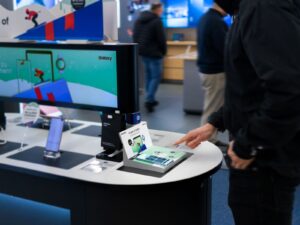
Brands can take customer feedback into account when designing their in-store experiences to create interactive product demonstrations. This will enable them to create an engaging customer experience.
One brand example of interactive product demonstrations in retail is Samsung. Samsung utilizes interactive displays in its retail stores to showcase the features and capabilities of its latest devices.
Customers can engage with the devices, explore various functionalities, and experience hands-on demos. These interactive product demonstrations allow customers to have a firsthand experience with Samsung’s products, fostering a deeper understanding and connection with the brand.
17. Make Them Feel Exclusive

Luxury retailers often offer exclusive VIP experiences for their high-value customers. This could include private shopping events, personalized styling sessions, or access to limited-edition products.
Gucci offers exclusive VIP experiences to its high-value customers, including private fashion shows, personalized styling sessions with renowned stylists, and access to limited-edition collections. By analyzing customer feedback, Gucci has created a VIP exceptional customer experience, elevated customers’ shopping journeys, and created a sense of exclusivity for their most valued customers.
18. Give Back To The Society

Retailers that actively engage with their local communities can build strong connections with customers. Hosting events, partnering with local charities, or supporting local artisans can create a sense of belonging and loyalty among customers.
Lush Cosmetics demonstrates community engagement by partnering with local charities, organizing fundraising events, and actively promoting ethical and sustainable practices in their product offerings.
Lush Cosmetic’s integration of customer feedback into its community engagement strategy allows it to continuously refine its strategy community programs, and deliver more meaningful programs.
One notable example is their ‘Charity Pot’ program. Lush created the Charity Pot body lotion, and 100% of the proceeds from its sales (excluding
19. You Can’t Be Always There, So Use Virtual Shopping Assistants
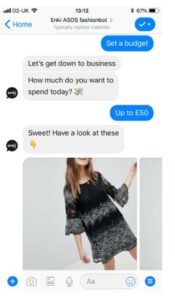
Retailers are leveraging AI-powered virtual shopping assistants to provide personalized recommendations and assistance to customers. By using customer feedback and data, these assistants can offer product suggestions, answer questions, and guide customers throughout their shopping journey.
Retail customer experience examples like ASOS, a leading online fashion retailer, has implemented Virtual Shopping Assistants to enhance the customer experience. Through their “Enki” virtual assistant, ASOS provides personalized product recommendations, style advice, and assistance to customers while they browse the website.
“Enki” engages in natural language conversations, understands customer preferences, and offers tailored suggestions based on individual tastes and past purchases.
20. No Holdup in the Payment Process Please!
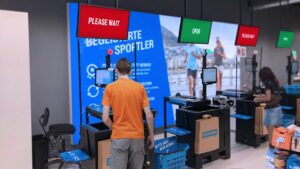
Some retailers are embracing innovative payment options to enhance the customer experience by including, contactless payments, mobile wallets, and self-checkout systems. This offers convenience and speed during the purchasing process.
One brand that is excelling here is Decathlon.
By gathering and analyzing customer feedback, Decathlon understood that their payment process needs to be hassle-free to reduce customer wait times.
Decathlon introduced a hassle-free shopping experience by installing self-checkout counters equipped with a scan and pay app for billing. This allows customers to scan and pay for their purchases using their smartphones which automatically disables their RFID security tag.
To sum up,
The retail customer experience examples provided demonstrate the immense value of going above and beyond traditional shopping experiences in retail.
By embracing innovation, personalization, community engagement, and surprise elements, retailers can create extraordinary customer experiences that leave a lasting impact. These experiences not only cultivate customer loyalty and satisfaction but also contribute to the overall success and growth of businesses.
As the retail industry changes, it’s crucial for retailers to focus on customers. They should gather feedback to know their needs and expectations.






